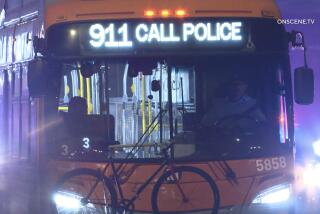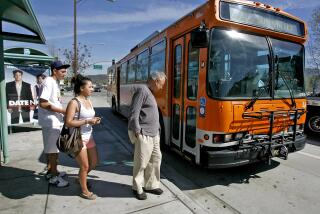A San Diego bus route provides a vital lifeline for neighborhood during pandemic
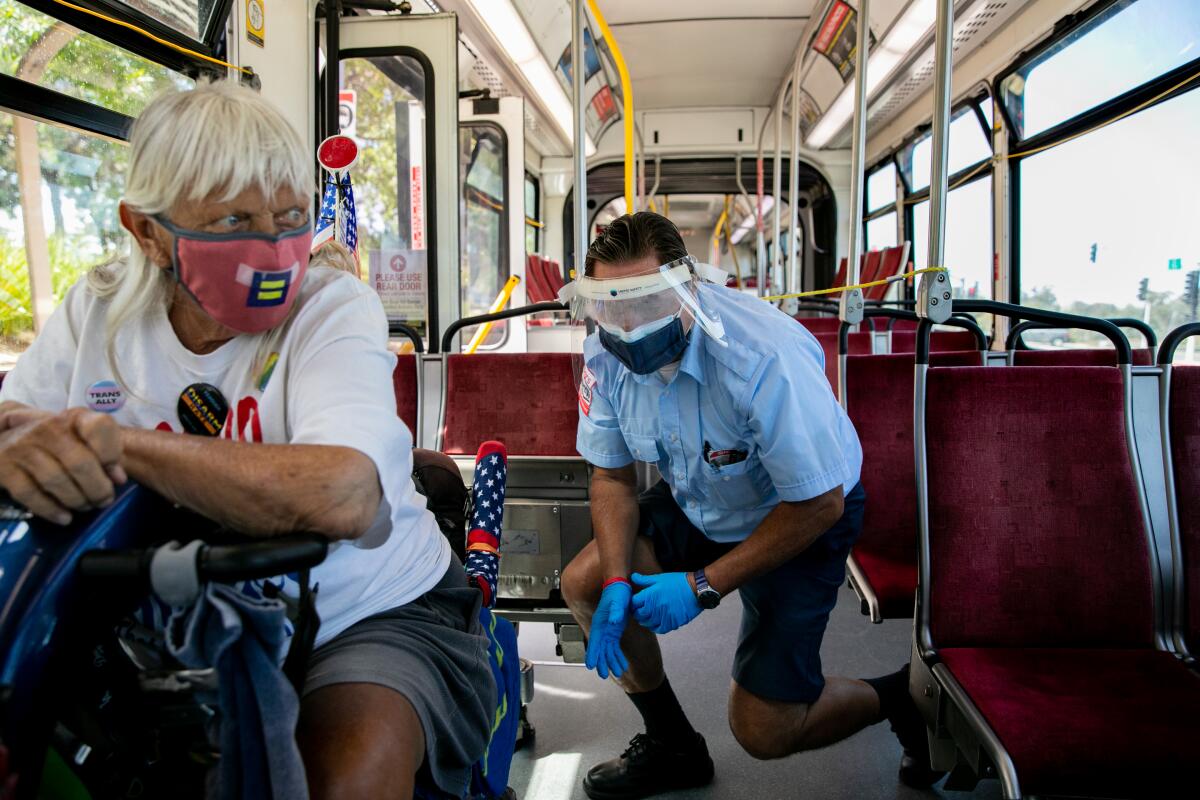
SAN DIEGO — In normal times, Roland Howard would cherish his time riding the Route 7 bus.
The former pastor and university professor, who uses a motorized wheelchair, strikes up conversations with fellow riders whenever possible. He even found his current church through a driver, who’s also a preacher.
But when Howard, 67, rolled off the bus at University Avenue and 47th Street after a dentist’s appointment last week, he admitted to feeling a bit uneasy. Taking the bus is probably the biggest risk he takes now when it comes to COVID-19 — from exposure to strangers to the close contact with drivers who help him board and exit.
“I’m concerned about this virus that’s going around,” he said through a blue surgical mask. “Because of my age and because I have a lot of ongoing disabilities, everything that they say is conducive to [getting seriously ill], I’ve got.”
The neighborhood is full of people like Howard — older, many with disabilities, many who have no choice but to use public transit even in the midst of a pandemic.
For three months, as much of life froze across San Diego, the Route 7 bus kept rumbling along, connecting City Heights to downtown San Diego. Now it is providing a vital lifeline as this diverse neighborhood struggles to recover.
Today, Route 7 carries more passengers every day than any other bus in the San Diego Metropolitan Transit System. While ridership on other popular routes has plummeted 70% — more than 90% in some cases — people have continued to ride the Route 7 bus in sizable numbers, according to MTS data.
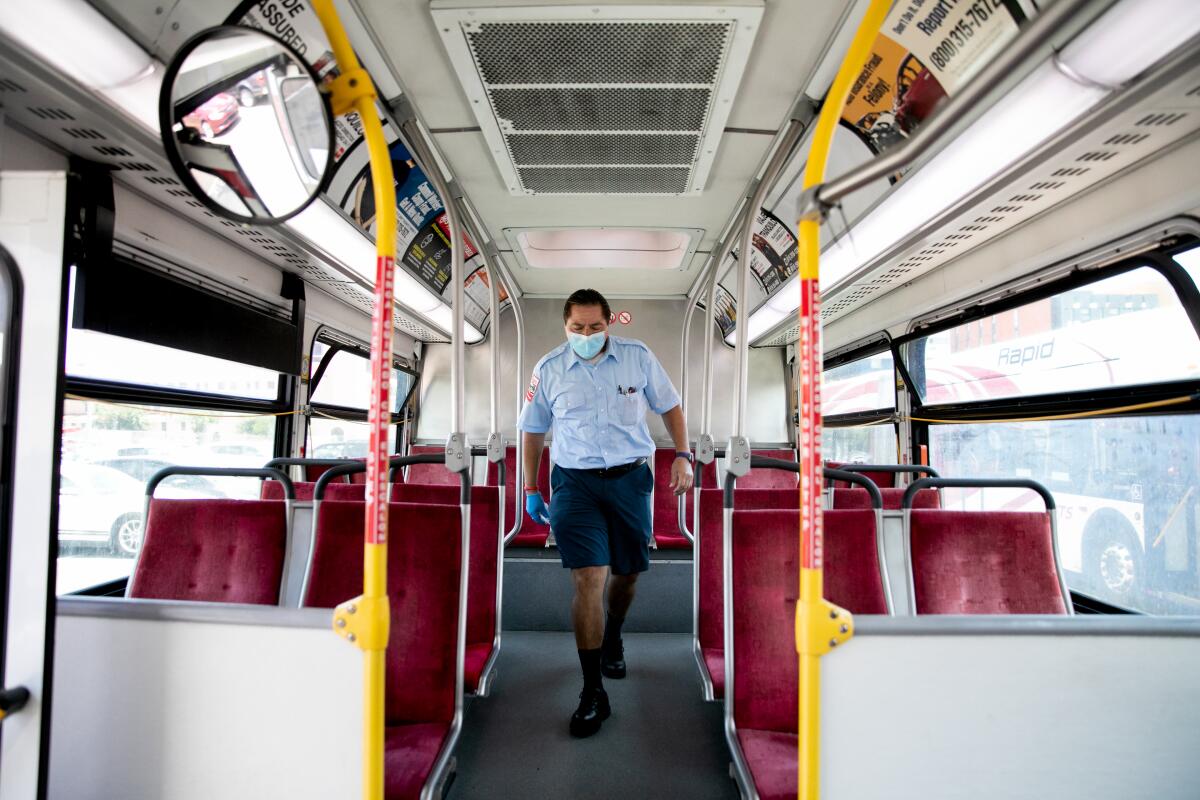
With ridership down a relatively modest 53%, the route still serves more than 3,100 passengers a day, all with varying degrees of dependence on the transit system.
Ron Dobbins, who lives about a block away from the stops on either side of University Avenue at 47th Street, is among them. On a recent weekday morning, he waited for the bus on the south side of the road in front of Pronto Laundry.
The 75-year-old has continued to take the bus a couple times a day despite the coronavirus. This time he was headed to pick up the newspaper at a nearby 7-Eleven, he explained through a mask, his short, white hair peeking out from under a baseball cap.
Dobbins knows he’s particularly vulnerable to the disease as a senior. But if he’s worried, he doesn’t let on. On the upside, he said, there’s been lots of room on the bus since ridership declined.
“I’m nervous when I have to cross the street, I mean, the way these people drive. I’m nervous when I see some of these homeless people. They definitely look strange. Some of them are on drugs. Some of them are mentally ill. Some are using alcohol. ... That makes me nervous,” he said, “but not the bus.”
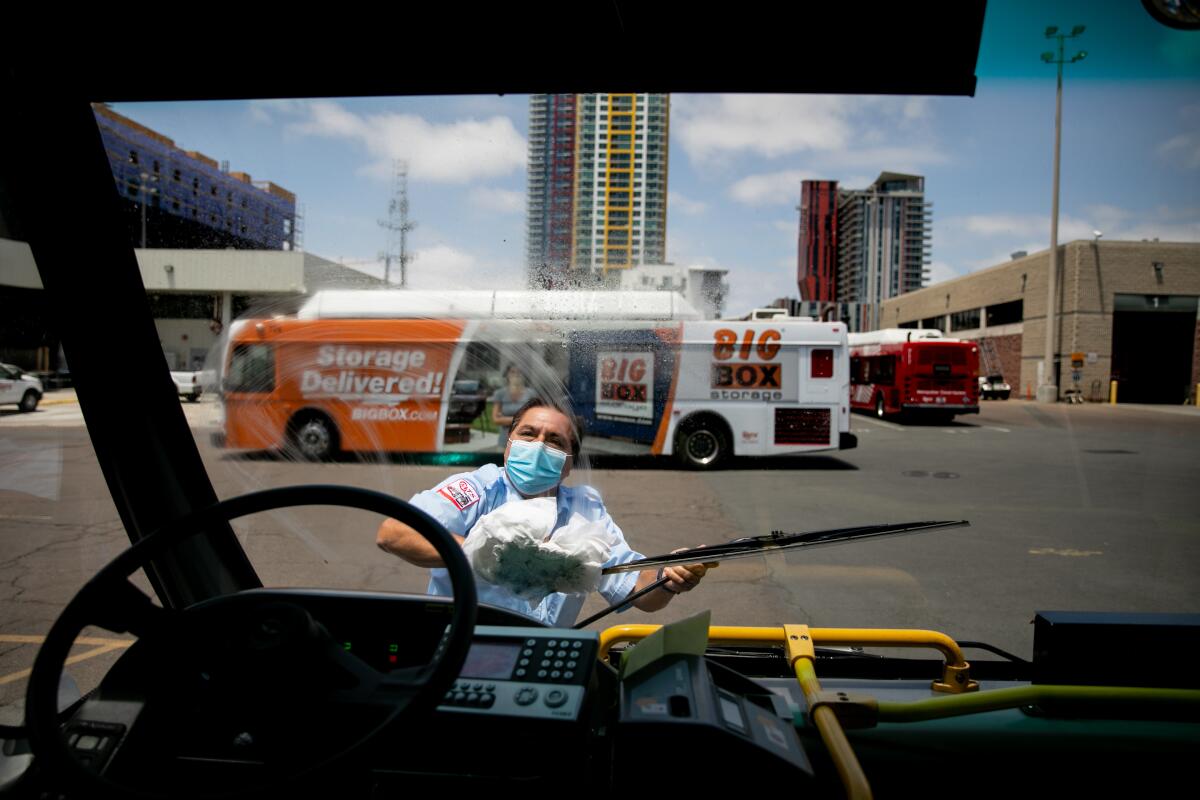
Later that day, Dobbins and his wife sat under the red, metal bus stop shelter while their clothes washed at the laundromat. Several people were waiting for their laundry in their cars, as the businesses wasn’t letting people hang out inside.
A few minutes later, Kirk Taylor, 55, got off the bus. Grappling with several disabilities, he said he uses transit to get to medical appointments.
“The bus is the riskiest because you don’t know what to touch,” he said. “That part’s really tricky. You have to wash your hands a whole lot and not put them in your face.”
As restaurants, bars and other businesses in City Heights and elsewhere have reopened, bus ridership has ticked up in recent weeks on the 7, as well as on Route 10, which also runs along University Avenue but connects to Old Town, instead of downtown.
Taylor said that people on the bus have recently become more relaxed about efforts to prevent the spread of the virus. Perhaps surprisingly, that’s made him feel more at ease while riding.
“About a month ago, people would get on there with gloves and the face mask. Now it’s a lot less intense because things are almost back to normal as far as the buses,” he said.
Coronavirus infections have recently started to spike as the economy reopens. Since mid-June, public health officials have recorded at least 10 community outbreaks across the county, which they define as three or more cases from different households linked to a specific location.
Just Tuesday, the county recorded a record daily total of 332 positive test results, which topped the previous record of 310 set the previous weekend. For weeks before the lockdown was lifted, the daily number of people being infected was usually in the low 100s.
None of the recent outbreaks have been traced to public transit. However, about a dozen bus drivers have tested positive for the virus, including one along Route 7. Most have since returned to work. None have died.
Christopher Castor, 56, a bus driver on Route 7, isn’t taking any chances. On a recent weekday afternoon, he used the blue surgical gloves and face shield provided by the agency as he helped folks in wheelchairs on and off the bus.
“I’m scared of catching it,” said Castor, a 56-year-old San Diego native who has lived in City Heights since 1974. “When I get home, everything comes off, jump right in the shower.”
The MTS put in place a number of safety precautions on its trolleys and buses to prevent the spread of the virus. The front of the bus is roped off and accessible only for people with disabilities. Other passengers board through the rear doors. Cash fare payments have been suspended at least until early July, when the MTS hopes to have plexiglass barriers installed to protect drivers.
For now, people flash their bus passes as they board in what has evolved into something of an honor system. The agency also recently voted to lower fines for fare dodgers to $25 per violation, down from nearly $200.
Castor, who has had the route for five years, is as much tour guide as driver. He likes to tell riders about the history of the buildings passing by, dropping bits of trivia, such as how City Heights was briefly its own city called East San Diego until the city of San Diego annexed it in 1923.
“City Heights was still called East San Diego until the ‘80s,” he said, steering smoothly through traffic.
He could have chosen a different, perhaps more desirable route with his seniority at the MTS, Castor said, but he enjoys serving his own community.
“When I first did it, everybody’s like, ‘Man, why?’ It’s always there. Nobody wants it,’” he said. “I love the people, and it’s cool. The people know me.”
One of Castor’s favorite stories is how Route 7 was named after the former streetcar by the same number, which ran from downtown through Balboa Park to a turnaround at the current location of the Tower Bar. It was one of the last three streetcar routes in operation before the system was shut down in 1949. The transit system was privately run until 1967, when the city took it over.
Many of the landmarks Castor passes have been shuttered for weeks and are just now coming back to life. On a recent afternoon, Bruce Grizer, 60, stopped into the Tower Bar for a pint to break up his bus commute between Kearny Mesa and South Crest. The bar at University and Euclid avenues reopened on June 12 with social-distancing adjustments — plexiglass shields, fewer bar stools, taped-off service lines.
Count Grizer among those who believe the coronavirus worries are overblown.
“My personal opinion is the hysteria is fueled by the government and, I’m sorry, but also the media,” said Grizer, who writes technical journals. “I spent 35 years in the medical industry, and [I’ve] seen the bird flu, swine flu, whatever flu you want to talk about. To me, this is just another variation.”
He said he didn’t know of anyone who’s been sick with the virus. Bartender Tasha Parker, 34, chimed in that her cousin caught it and had to be on a ventilator for nearly a week.
Like the businesses along University Avenue, some Route 7 riders are coming back for the first time in a long time. Tim Cutter was waiting at a stop in front of San Diego Electric for a bus to take him to work in Hillcrest. A cashier for Ace Parking at Scripps Mercy Hospital, Cutter said his motorcycle was in the shop and this would be his first time taking the bus since the lockdown started.
“You know, I was a little nervous at the beginning, but actually I took a look at the bus before I hopped onto it, and there’s actually enough space there, you know,” Cutter, 61, said through a thick black mask strapped tightly against a massive white beard. “I wear gloves, I wear [a] protective mask when I get on there so I’m not touching anything that could be contaminated.”
Not everyone in the neighborhood is rooting for mass transit to come roaring back. The guys working inside San Diego Electric have had an often contentious relationship with those who hang out around the bus stop. They say the shop’s metal rollup door has been routinely tagged with spray paint, sometimes several times a week.
That hasn’t happened since the lockdown, said longtime employee Frank May. “It used to be every weekend, but since the virus shutdown …”
“ … it don’t happen no more,” co-worker Gene Anderson finished his sentence.
For most folks that use the bus, it’s an indispensable resource. It’s a place to socialize. It’s a government service that provides freedom to those who otherwise would’t get to enjoy it.
The bus became indispensable to Howard after he was pistol whipped repeatedly in the head during a robbery in Atlanta, where he was teaching divinity and English classes.
Howard said he was in a coma for more than two months following the attack, and when he came out of it, his right side was paralyzed for about eight years.
He fought his way back to health and established a community in San Diego. Young men regularly called him seeking his guidance, he said.
Now the virus has threatened to upend that.
“I like to communicate with people,” he said, “and I get to know all of the different drivers and talk with the people that are there. I kind of just include everybody.”
Smith writes for the San Diego Union-Tribune.
More to Read
Sign up for Essential California
The most important California stories and recommendations in your inbox every morning.
You may occasionally receive promotional content from the Los Angeles Times.
